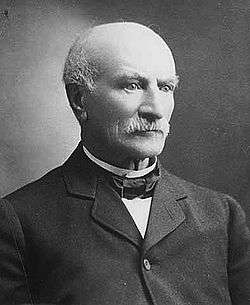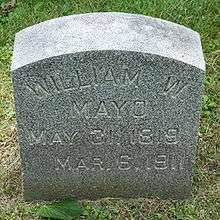William Worrall Mayo

William Worrall Mayo (/ˈmeɪjoʊ/; May 31, 1819 – March 6, 1911) was a British-American medical doctor and chemist, best known for establishing the private medical practice that later evolved into the Mayo Clinic. He was a descendant of a famous English chemist, John Mayow. His sons, William James Mayo and Charles Horace Mayo, established a joint medical practice in Rochester in the U.S. state of Minnesota in the 1880s.
Early life
William Worall Mayo was born in Salford, Greater Manchester, England, and studied science in Manchester, under John Dalton, the chemist and physicist responsible for formulating the modern atomic theory of matter and devising the periodic table. Mayo left for the U.S. in 1846. His first work in his new country was as a pharmacist at Bellevue Hospital in New York City, though he soon moved westward.
Mayo spent a brief period of time in Buffalo, New York before settling in Lafayette, Indiana where he worked as a tailor (one of the vocations he had while in England). He returned to medicine in 1849, assisting in a cholera outbreak and then attending courses at Indiana Medical College in La Porte, Indiana where he earned his medical degree. Although the training there would probably be considered mediocre by modern standards, the school did have a microscope, an uncommon tool at the time. Knowledge of how to use this instrument proved to be useful in Mayo's future practice. He received his M.D. degree on February 14, 1850.
Migrating west
In 1851, Mayo married Louise Abigail Wright (December 23, 1825 – July 15, 1915), and two years later, they had their first child, Gertrude. Around this time, Mayo left for a winter to work as an assistant at the University of Missouri's medical department. He returned in 1854, but contracted malaria and decided to leave the Lafayette area, saying, "I'm going to keep on driving until I get well or die." Mayo found his way to Minnesota, which he thought would have a more healthful climate and where he did recover from malaria. He settled in Saint Paul, but returned to Indiana a short time later to bring his family to the Minnesota territory. Mayo then found his way to the present-day area of Duluth where he worked as a census-taker.
He brought his family to a village named Cronan's Precinct (near Le Sueur) along the Minnesota River where he became known as the "Little Doctor" because of his 5-foot-4-inch (1.63 m) stature. Mayo tried his hand at a number of different activities including farming, operating a ferry service, and serving as a justice of the peace in addition to occasional medical duties. By this time, he had two more daughters in his family, Phoebe and Sarah.
After a flood in 1859, the family moved to a home on Main Street in Le Sueur. There, he set up his first official medical practice, but the flow of patients was too meager to support the family. Mayo took to publishing a short-lived newspaper, the Le Sueur Courier, which only lasted about three months. He also spent time working on a steamboat. The family saw its first male addition, William James Mayo, in 1861.
As the American Civil War began that same year, Mayo attempted to procure a commission as a military surgeon, but was rejected. Nonetheless, he found his way into military medicine as the Dakota War of 1862 erupted in southwest Minnesota in late 1862. Organizing a group of people from Le Sueur and St. Peter, Mayo headed out to New Ulm, where some of the worst fighting had occurred. Makeshift hospitals in the city cared for people injured in the conflict, as well as refugees driven from farms in the area. His wife opened her home and a nearby barn to harbor eleven refugee families back in Le Sueur. After 38 Sioux were executed for participating in the rebellion, Mayo stole the corpse of a Sioux named Cut Nose for dissection and an anatomy lesson for other doctors in the Le Sueur area.[1]
Rochester
In 1863, Mayo finally was engaged as a military surgeon for the draft board in Rochester, Minnesota. He left his family for that position and soon found the new city to his liking, so they joined him there in early 1864. A year later, his son Charles Horace Mayo was born.
Dr.William W. Mayo opened a medical practice in Rochester, also spending time as a city mayor, alderman, and member of the school board. He served in the Minnesota State Senate 1891-1895.[2] By now, the number of patients was large enough to support the family with no need for him to assume additional jobs. Mayo spent some time in New York and Pennsylvania in 1869 studying surgical techniques.
The event that is usually credited with beginning the "Mayo Clinic Story" happened in 1883, when a tornado devastated Rochester. The most seriously wounded were tended at the German Library in Rommel's Hall with Dr David Berkman as steward. Since many of the patients would need intensive care beyond what was being provided by the patient's relatives and friends, Dr Mayo recruited the local Sisters of Saint Francis of Rochester, Minnesota to be nurses. William J Mayo had just completed medical school, and Charles H Mayo was in his final year of school, so both were able to assist their father with care of the cyclone's victims. Mother Alfred Moes of the Sisters of St. Francis was convinced an actual hospital was needed in Rochester and approached Dr W. W. Mayo to head it. She offered to raise the funds and supervise construction of the hospital.Under her direction, St. Marys Hospital was built and opened in 1889. Originally, St Mary's Hospital had 12 beds, the three Mayo doctors as surgeons, and the Sisters of St Francis as staff.
Mayo Clinic
In 1892, William Worrall Mayo asked Augustus Stinchfield to join his practice as a full partner. Once Stinchfield accepted the offer, W. W. Mayo promptly retired at age 73. As the practice grew, Christopher Graham, E. Starr Judd, Henry Stanley Plummer, Melvin Millet, and Donald Balfour were also invited to join it as partners. In 1919, the partners of the private practice created the Mayo Properties Association and established the Mayo Clinic as a not-for-profit entity.

In 1910, W. W. Mayo became interested in the extraction and distillation of alcohol from animal and vegetable wastes, and one day suffered a serious injury when the extraction mechanism crushed his arm and hand. That injury necessitated an amputation. Complications resulted in his death in March 1911, shortly before Mayo's 92nd birthday. His wife died in 1915. They are buried next to each other at Oakwood Cemetery in Rochester.
The family's home in Le Sueur was added to the National Register of Historic Places in 1969. Carson Nesbit Cosgrove and his family later lived in the home. Cosgrove went on to help create the Minnesota Valley Canning Company, later named Green Giant. Dr W. W. Mayo's home in Rochester was razed to build the original Mayo Clinic building in 1914.
W. W. Mayo is honored together with Charles Menninger and their sons with a feast day on the liturgical calendar of the Episcopal Church (USA) on March 6.
References
- ↑ Clapesattle, Helen (1969). The Doctors Mayo. Rochester, MN: Mayo Clinic; 2nd edition. ISBN 978-5-555-50282-7 pp. 77-78.
- ↑ "Minnesota Legislators Past & Present - Legislator Record - Mayo, William Worrall". Leg.state.mn.us. Retrieved 2010-09-04.
Sources
- Mayo Family Story
- Clapesattle, Helen. The Doctors Mayo, University of Minnesota Press (1975). ISBN 0-8166-0465-7
- Hartzell, Judith. "I Started All This: The Life of Dr. William Worrall Mayo", Arvi Books (2004). ISBN 0-9703569-1-9
- Mayo, Charles W. "Mayo: The Story of My Family and My Career," Doubleday and Company (1968)
External links
| Wikimedia Commons has media related to William Worrall Mayo. |
| Preceded by Samuel Whitten |
Mayor of Rochester, Minnesota 1882 – 1883 |
Succeeded by Samuel Whitten |